7 ways to collect Customer-First Data™ and retain customers beyond the holidays

The marketing autopilot is broken. The world is facing a cookieless future.
And with the pandemic still raging, supply chain issues, and ever-changing customer expectations, businesses are facing a tough new reality heading into 2022.
But if you focus on gathering data on your business, you can leverage that valuable information well into the new year. In other words, prioritize data ownership over everything else.
There’s a new holiday marketing playbook
With the challenges of the past two years, ecommerce merchants are forced to change their holiday marketing strategies. It’s worth exploring the shifts in the industry to understand the context behind the evolving holiday marketing landscape.
Earlier holiday marketing due to supply chain issues
Data from the US Census Bureau shows almost 40% of US businesses experienced—or are still experiencing—supply chain delays due to COVID-19. These shipping and inventory headaches forced many ecommerce merchants to begin sales earlier than ever before to ensure delivery in time for the holidays.
Retailers aren’t the only ones who are worried. According to Accenture, 34% of consumers said they were also concerned about supply chain issues. In fact, 75% of consumers planned to start their holiday shopping earlier due to concerns about limited stock and shipping delays, according to data from Deloitte.
Unlike seasons past, when holiday shopping began in earnest on Black Friday through Cyber Monday, 2021 saw retailers starting their promotions earlier in November. This year’s holiday shopping season is expected to last more than six weeks, according to Deloitte’s 2021 Holiday Retail Survey.
The supply chain issues presented many challenges, including customer loyalty. Just 13% of consumers were willing to wait for a retailer to replenish a product that was out of stock. Instead, about 70% decided to take their business elsewhere.
Every website visit is a hard-won battle for attention that brands can’t afford to lose. One of the top priorities for retailers in 2022 will be to gain and retain customer loyalty—despite ongoing supply chain issues.
Omnichannel shopping
Most businesses have finally realized there isn’t a battle between retail and ecommerce—essentially, it’s all the same. This new hybrid shopping experience is known as omnichannel.
As a result of this shift in consumer behavior, today’s brands need to create the best possible customer experience across every touchpoint, and not just aim their focus on either the online or in-store experience.
Today’s consumers use all options available to them before settling on a purchase. They look at products in-store and online. They may first review a product on their phone and then look at it again on a laptop at home. According to Google, 60% of customers start shopping on one device and complete their purchase on another one.
And for most holiday-related categories, 60-70% of consumers say they’re shopping across multiple channels, as reported by McKinsey. To capitalize on new customer behaviors, retailers have to prioritize creating a seamless omnichannel experience.
The power of social media
Customers today spend a lot of time scrolling through their social media feeds, searching for inspiration—especially during the holidays.
McKinsey data shows that 58% of consumers are influenced by social media when it comes to holiday buying decisions. The same research shows 87% of Gen Z shoppers are inspired by social media—with YouTube, Instagram, and TikTok as their most likely sources of inspiration.

Social commerce is also on the rise, and it’s expected to grow by almost 35% this year.
According to eMarketer, US social commerce is expected to surpass $36B and reach $80B by 2025. The statistics underline the importance of social media as part of a successful marketing mix. But the rising data privacy concerns raise new questions that marketers need to address.
A future without third-party cookies
One of the most profound changes for retailers was the announcement of the elimination of cookies, which is a small piece of text sent to your browser when you visit a website. Cookies help websites remember information about your visit.
But the launch of Apple’s iOS 14.5 and Google’s announcement of its plans to phase out third-party cookies turned the digital marketing world upside down. According to the Adobe Digital Trends report, 60% of senior executives predict that being forced to adapt to the new requirements will have a “disruptive effect” on their marketing strategies.
Advertising is becoming more expensive and less effective, so marketing professionals need to focus on data ownership.
Instead of relying on third-party applications where data will provide diminishing returns, smart ecommerce businesses will start collecting Customer-First Data™.
Why is Customer-First Data important?
- Address growing privacy concerns. As consumers become more aware of their data rights, they are beginning to voice their concerns about privacy issues. As reported by The Drum, 85% of U.S. consumers prioritize their personal privacy data more than they did a year ago. Big tech companies such as Apple and Google have also recognized the importance of customer privacy and responded with data privacy changes. While moving the focus to first-party data will require a mindset shift, it will help retailers address growing privacy concerns and become less reliant on third-party data.
- Build a stronger connection with customers. Instead of choosing a generic marketing approach, focus on getting a 360º view of the customer with rich data. Gather all your customer data in one place and act upon the information. This way, you’ll be able to understand your customers’ needs and exceed their expectations.
- Create a better customer experience and build trust. To collect first-party data, you have to offer true value and be transparent with your customers in the process. Give them control over their own data and explain why you collect data in the first place. When you create a better customer experience based on the data you collect, it will build trust and strengthen your relationship with customers.
- Increase your bottom line. More data means personalized experiences, which leads to higher conversion rates. Data from Google shows that using first-party data helps marketers achieve almost a 300% boost in revenue while improving their cost savings by 150%.
- Futureproof your business. Data is one of the biggest concerns for ecommerce businesses. Owning customer data instead of relying on third-party cookies will help improve your decision-making and protect your business from future changes.
How to collect Customer-First Data to retain customers during the holidays and beyond
Instead of focusing on one-time sales, you need to shift your perspective and prioritize gathering Customer-First Data to leverage beyond the holidays. Here are seven strategies from businesses that have successfully used data ownership to improve their ecommerce sales.
1 | Use sign-up forms for a personalized experience
If you’re not sure where to start with Customer-First Data, setting up pop-up forms is one of the easiest ways to get information and build a robust customer profile. This is especially important for first-time website visitors from whom you don’t have a lot of behavioral information.
Always take the context into consideration and adjust your message. For example, if you ask visitors for their birth date, offer them a birthday gift. The New York City-based jewelry company Catbird uses its email sign-up form to collect email addresses and birth dates. In return, customers get a 10% discount and a birthday treat.

When it comes to the information that you can collect with a sign-up form, the possibilities are endless. Tomlinson’s Feed—a pet store in Austin, TX—gives first-time customers a gift for their pet by simply asking if they are a dog or a cat person. The sign-up form helps ecommerce businesses easily target their customers with personalized messages.
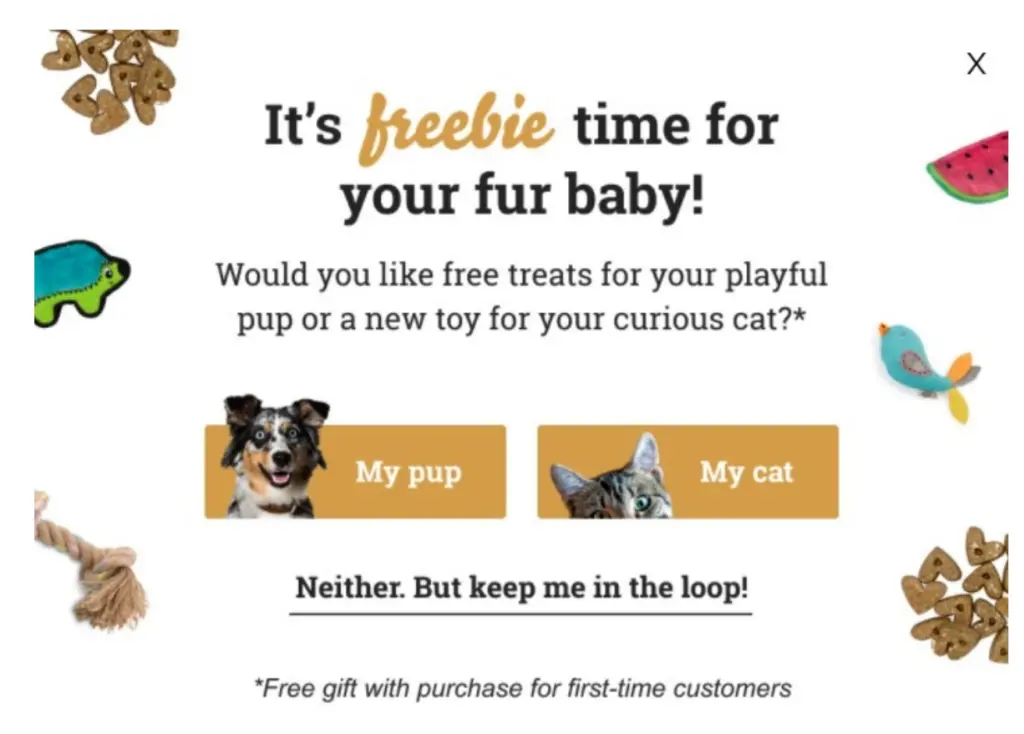
2 | Increase conversions through email marketing automation
Once you collect customers’ email addresses, you can create funnels and track behavioral cues. Setting up a welcome email series is a great way to connect with your customers and make a special offer to encourage their first purchase.
A welcome email series can yield strong results when done correctly—the average welcome message has a 63% higher open rate and 86% higher click rate compared with a traditional email campaign.
According to Baymard, the average online shopping cart abandonment rate is almost 70%. But the good news is that you can recover some of those lost sales with an abandoned cart email. Data from Moosend shows that the email open rate for cart abandonment emails is 45%, with 21% of those opened emails receiving click-throughs—and half of the recipients who engaged with the content of the email finished their purchase.
Why is email marketing important for Customer-First Data?
Email marketing can help you track customer behavior and collect valuable information about customer preferences. Including product recommendations in your welcome series or adding similar products in your abandoned cart email is a great way to get more insights about your customers that can serve as the basis of your customer retention marketing strategy.
Brava Fabrics is an eco-friendly apparel brand on a mission to offer fashion with a purpose. This digitally native brand uses the power of email marketing to boost online conversions. Even though they include paid advertising in their marketing strategy, they don’t have the same control over that data as they do with their owned channels. This makes email marketing one of the most important marketing tools for Brava Fabrics.
Using email marketing automation allows Brava Fabrics to create memorable experiences across the entire customer lifecycle. They can tailor the message that a customer receives after their first visit to Brava Fabrics’ website, when they add a product to their cart, after purchase, and finally—with reviews and brand advocacy. The results speak for itself: 60% of Brava Fabrics’ email revenue comes from automated emails.
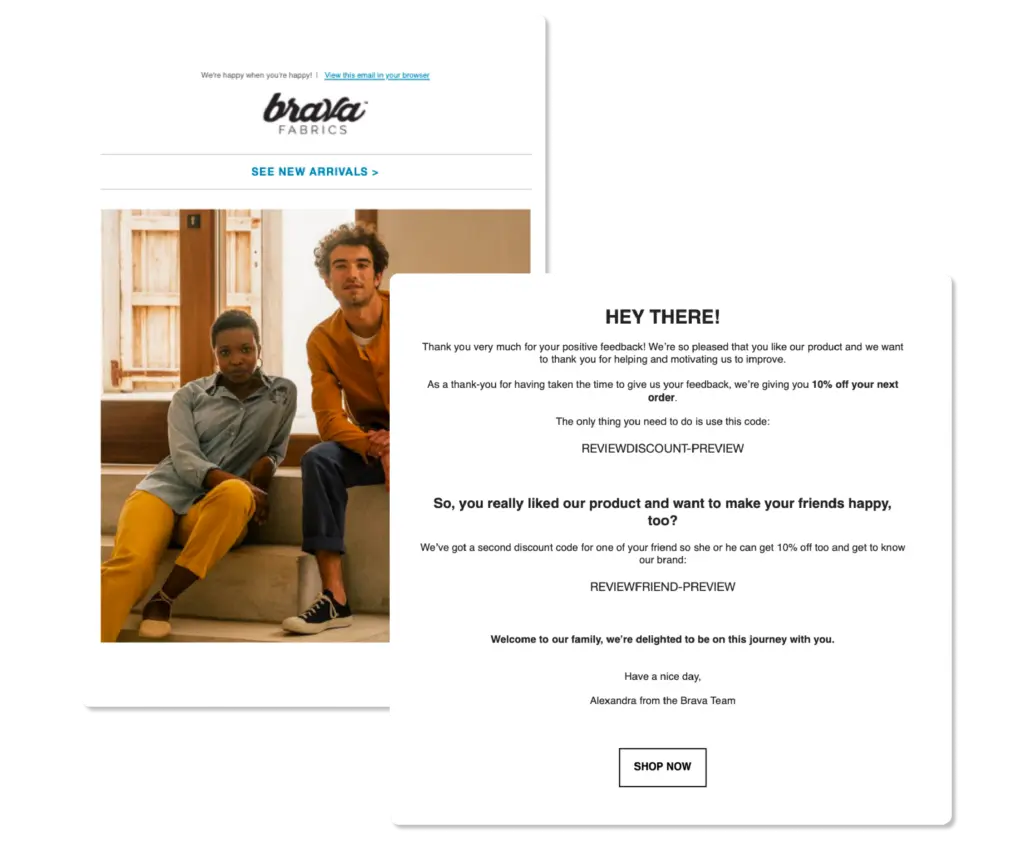
3 | Boost revenue through SMS marketing
Mobile devices have become an inseparable part of our lives—and SMS marketing has emerged as one of the fastest-growing tools for marketers. Why? Because it works.
As reported by Learn Hub, 70% of consumers think SMS marketing is a great way for businesses to get their attention. Proving that point, 82% of people claim that they open every text message they receive.
GhostBed is a great example of a company using SMS marketing as one of its key growth strategies. The bed-in-a-box mattress brand has generated $77,600 from a single SMS welcome series flow, with a 32% click rate and 2.5% order rate.
The moment you land on GhostBed’s website, there’s a sign-up form asking customers for their email address and phone number. Once they collect that information, there are countless possibilities to build a strong customer relationship using SMS marketing.
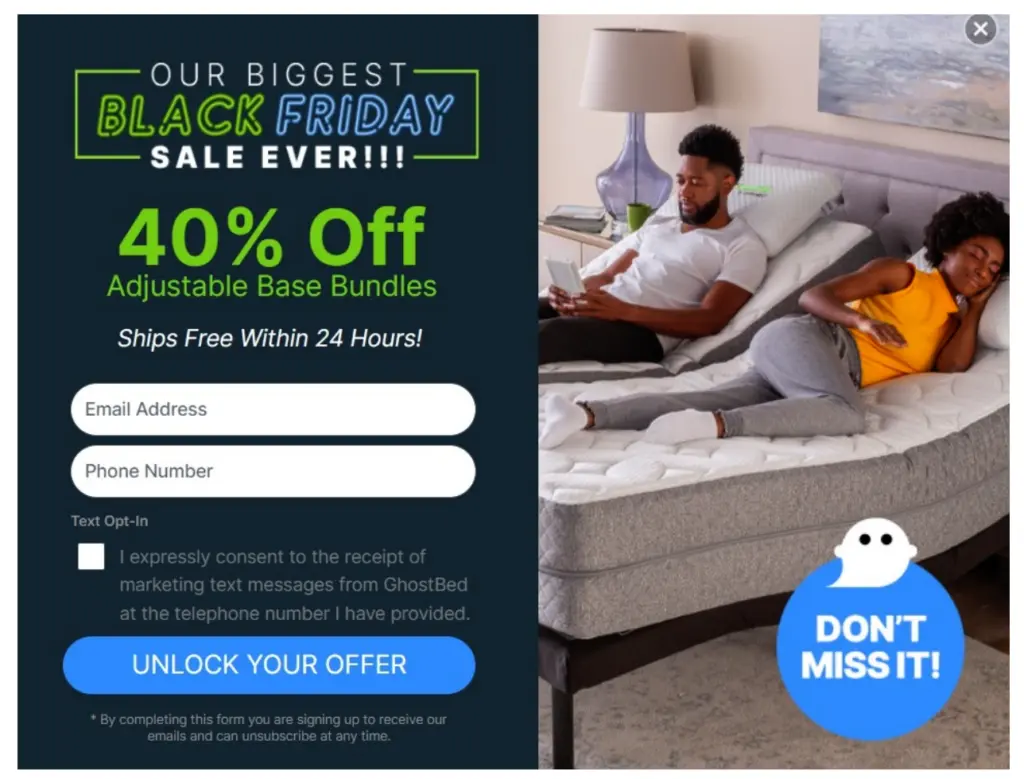
4 | Engage customers with quizzes
People love quizzes. They’re fun, but they can reveal who people really are.
“It goes into our own ongoing developing narrative and it gives some credence of ourselves as heroes of our own story,” Robert Simmermon, PhD, a psychologist in Atlanta, said of quizzes in The Huffington Post.
The fact that people enjoy taking quizzes makes it one of the best ways for marketers to get to know their customers better—and gather valuable data. According to Octane.ai, quizzes have 10-30% higher conversion to sale compared with the average website conversion rate of 2-4%.
Once you attract visitors to your website, you can ask them questions and give product recommendations based on their answers. Later, you can use the Customer-First Data to personalize flows and campaigns.
The shapewear brand CYSM used this tactic during its Black Friday sale. They created a special quiz, giving customers personalized product recommendations. CYSM’s customers can always find specific campaign quizzes for special sale events like Black Friday.
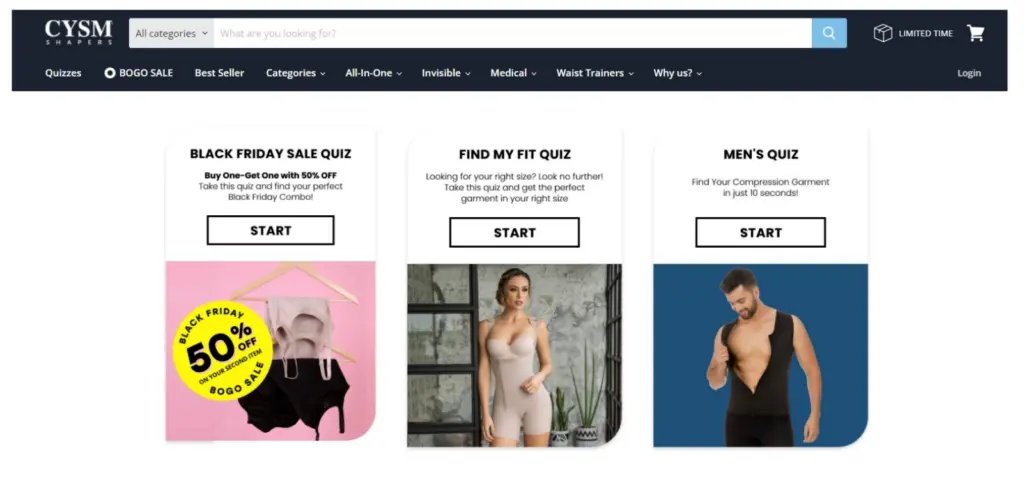
5 | Offer virtual consultations
While the pandemic has fueled a surge in ecommerce, it has pushed brands to rethink how they can create an online shopping experience for their customers that simulates the intimacy of an in-store transaction.
According to PwC, 82% of US consumers want more human interaction during the retail experience. As a result, retailers are using live chat tools or virtual video consultations to give customers advice, answer their questions, and help them make a decision on their purchase.
A virtual consultation is not just a good customer experience, it also helps merchants gather Customer-First Data
Catbird offers consultations to help their customers find a special gift, like an engagement ring. To book an appointment with one of their in-person or virtual consultants, customers fill out a form with availability along with their email address and phone number.
Customers also answer a few questions about their budget and jewelry preferences. Armed with this information, Catbird’s experts can help their customers find the best product to suit their needs. And since Catbird owns this data, they have the tools they need to build a long-term relationship with their customers.
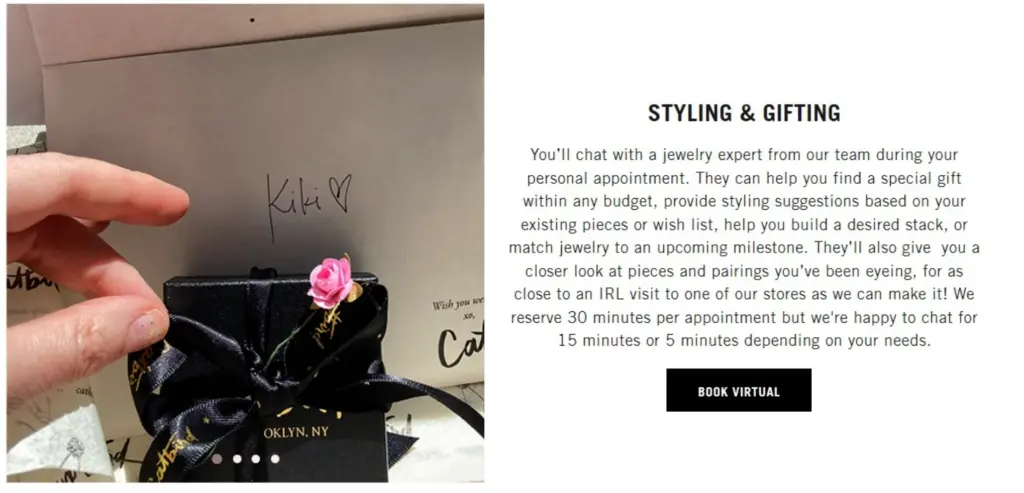
6 | Send out customer surveys
Feedback from customers, whether positive or negative, is vital to developing a long-term relationship. To satisfy your customers’ expectations, you have to see things from their point of view.
If you want to see what your customers think about a new product launch, or understand how they feel about your customer service—surveys are a good way to get a sense of what your customers are actually thinking. It’s also a great way to collect Customer-First Data.
Reality check: While marketers know they should make data-driven decisions in theory, fewer than 40% of marketers use consumer research to drive decisions, according to Google.
A few days before Cyber Monday, Detroit-based Floyd, a direct-to-consumer (DTC) furniture brand, sent out a survey to gather more information about their customers’ thoughts on bean bag chairs. Customers who filled out the survey had a chance to win a $1,000 coupon.

7 | Include QR codes in your marketing strategy
QR codes aren’t new, but they experienced a major comeback in 2020. A decade ago, customers had to download a QR scanner to be able to open a QR code. However, as smartphones come with built-in QR code scanners, marketers have finally started incorporating QR codes into their campaigns.
It seems that QR codes are here to stay—59% of shoppers in the United States believe they will use QR codes permanently.
By using QR codes, marketers can direct customers toward a landing page or bridge the online-offline gap by placing a QR code on their products.
But by adding unique, trackable links (UTMs), you can measure the impact of your QR code campaign and track behavior data in the purchase process. You can also use the collected data for retargeting customers on social media and through search engines to boost sales.
The apéritif brand Haus encourages customers to scan the QR code placed on the bottle for direct access to recipes and playlists. This innovation allows customers to get an engaging experience, while Haus can understand its customers’ behavior and preferences.

Get ready for a cookieless future
We’ve only scratched the surface of the possibilities that Customer-First Data can bring to your business. Understand macroeconomic trends and instead of focusing on short-lived campaigns this holiday season, make sure to gather rich customer information you can use long after the holidays. Prioritizing ownership over third-party data can help set the groundwork for a successful modern company.

Related content

Stop wasting time debating attribution models. Learn why traditional attribution is flawed and how Klaviyo’s flexible settings help you measure true marketing impact.

Discover how leading brands use Klaviyo to grow subscription businesses. Learn strategies for upselling, personalization, retention flows, and advanced automations that increase lifetime value and reduce churn.

Migrating to Klaviyo? Get expert insights on timing, tools, and tips to maximize your impact before Black Friday & Cyber Monday.